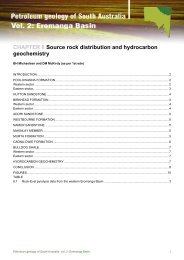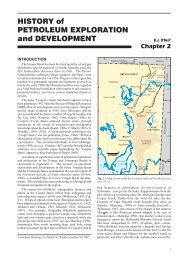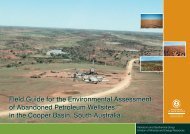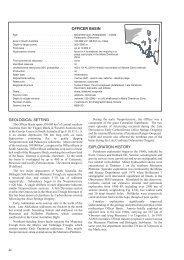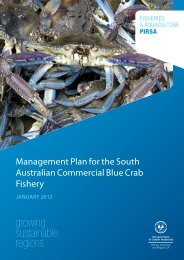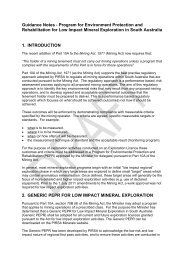Structural evolution of the Outalpa Inliers, Olary Domain ... - PIRSA
Structural evolution of the Outalpa Inliers, Olary Domain ... - PIRSA
Structural evolution of the Outalpa Inliers, Olary Domain ... - PIRSA
Create successful ePaper yourself
Turn your PDF publications into a flip-book with our unique Google optimized e-Paper software.
Geological Note<br />
<strong>Structural</strong> <strong>evolution</strong> <strong>of</strong> <strong>the</strong><br />
<strong>Outalpa</strong> <strong>Inliers</strong>, <strong>Olary</strong> <strong>Domain</strong>,<br />
Curnamona Province<br />
Richard Flint (Geosurveys Australia Pty Ltd)<br />
Introduction<br />
<strong>PIRSA</strong>, as part <strong>of</strong> <strong>the</strong> BHEI program,<br />
contracted Geosurveys Australia Pty<br />
Ltd to reappraise <strong>the</strong> geology <strong>of</strong> <strong>the</strong><br />
<strong>Outalpa</strong> <strong>Inliers</strong> in <strong>the</strong> central portion <strong>of</strong><br />
<strong>the</strong> <strong>Olary</strong> <strong>Domain</strong>, sou<strong>the</strong>rn Curnamona<br />
Province (Fig. 1), and produce a series<br />
<strong>of</strong> new digital and hardcopy lithological,<br />
lithostratigraphic, structural and metallogenic<br />
maps for <strong>the</strong> region (Flint,<br />
2001). Surface lithological mapping,<br />
and structural and airborne geophysical<br />
data were integrated into a new<br />
coherent 1:25 000 lithostratigraphic<br />
map incorporating both exposed and<br />
concealed portions <strong>of</strong> <strong>the</strong> inliers, and<br />
are <strong>the</strong> basis <strong>of</strong> a companion paper<br />
(Flint, in prep.). The present paper<br />
concentrates on <strong>the</strong> characteristics and<br />
nature <strong>of</strong> deformational episodes that<br />
have affected <strong>the</strong> Willyama Supergroup<br />
within <strong>the</strong> <strong>Olary</strong> <strong>Domain</strong>.<br />
A great challenge to a better<br />
understanding <strong>of</strong> <strong>the</strong> detailed strati-<br />
Fig. 1 Location plan <strong>of</strong> <strong>the</strong> <strong>Outalpa</strong> <strong>Inliers</strong> within <strong>the</strong> <strong>Olary</strong> <strong>Domain</strong>, Curnamona Province (after Flint and Parker, 1993; Preiss and Conor,<br />
2001).<br />
34<br />
MESA Journal 26 July 2002
Geological Note<br />
graphy for <strong>the</strong> Willyama Supergroup<br />
within <strong>the</strong> domain has been recognition<br />
<strong>of</strong> structural elements for <strong>the</strong> major<br />
deformational phases within <strong>the</strong><br />
Mesoproterozoic Olarian Orogeny. At<br />
least three main phases were identified<br />
more than 20 years ago, but since<br />
<strong>the</strong>n relatively few workers within <strong>the</strong><br />
region have successfully applied this<br />
classification scheme. This is due, in<br />
part, to a poor appreciation <strong>of</strong> <strong>the</strong> subtle<br />
differences between structural elements,<br />
and axial planes for various phases<br />
having a similar orientation in some<br />
areas. Orientation alone is not a sufficient<br />
distinguishing criteria — style <strong>of</strong> folding<br />
is also important, and <strong>the</strong> combination <strong>of</strong><br />
style, orientation and local overprinting<br />
criteria are all important to successfully<br />
delineate <strong>the</strong> various phases <strong>of</strong> <strong>the</strong><br />
Olarian Orogeny.<br />
No detailed regional study on<br />
structural <strong>evolution</strong> <strong>of</strong> <strong>the</strong> <strong>Olary</strong><br />
<strong>Domain</strong> has been undertaken, though<br />
syn<strong>the</strong>ses by Laing (1995a,b), primarily<br />
on lithology and lithostratigraphy, partly<br />
addressed structural considerations;<br />
Clarke et al. (1986) produced a regional<br />
structural syn<strong>the</strong>sis. Considerable<br />
structural data now exist for <strong>the</strong> <strong>Outalpa</strong><br />
<strong>Inliers</strong>, with University Honours<br />
mapping projects by Beckton (1993),<br />
Buckley (1993), Eykamp (1993),<br />
Middleton (1993), Peterson (1993),<br />
Benton (1994), Baulch (1995), Freeman<br />
(1995), Morton (1995), Fraser (1997),<br />
Pelling (1997) and Zdziarski (1997),<br />
an incompleted Ph.D project by Flint<br />
(1981), and mapping by Archibald<br />
(1980). All <strong>the</strong>ir point structural<br />
observations were digitally captured<br />
and, along with additional data collected<br />
during a 30-day field mapping program,<br />
now form a database containing >5450<br />
structural readings, permitting a detailed<br />
reappraisal <strong>of</strong> <strong>the</strong> tectonic <strong>evolution</strong> <strong>of</strong><br />
<strong>the</strong> <strong>Outalpa</strong> <strong>Inliers</strong>.<br />
Regional orogenesis<br />
Within <strong>the</strong> <strong>Olary</strong> <strong>Domain</strong>, deformation<br />
<strong>of</strong> <strong>the</strong> Olarian Orogeny occurred at<br />
~1600–1580 Ma during three main<br />
phases (OD 1<br />
to OD 3<br />
) that have produced<br />
a complex distribution <strong>of</strong> units (Glen et<br />
al., 1977; Berry et al., 1978; Grady et<br />
al., 1989; Clarke et al., 1986; Flint and<br />
Parker, 1993). The effects <strong>of</strong> refolding<br />
during two fur<strong>the</strong>r deformational phases<br />
(<strong>of</strong> <strong>the</strong> Palaeozoic Delamerian Orogeny)<br />
are relatively minimal.<br />
During OD 1<br />
, a layer-parallel<br />
schistosity and gneissosity developed<br />
during peak metamorphism at<br />
middle amphibolite facies, with local<br />
development <strong>of</strong> migmatite. However,<br />
<strong>the</strong> degree <strong>of</strong> folding during OD 1<br />
is<br />
enigmatic. Mesoscopic OD 1<br />
folds<br />
have only been observed rarely, but<br />
macroscopic recumbent folds with<br />
downward-facing stratigraphy have been<br />
proposed (Pointon, 1980; Clarke et al.,<br />
1986; Grady et al., 1989). Recognition<br />
<strong>of</strong> o<strong>the</strong>r OD 1<br />
folds is hampered by<br />
<strong>the</strong> intensity <strong>of</strong> refolding during later<br />
deformational phases.<br />
The second deformational episode<br />
(OD 2<br />
) varied in intensity across <strong>the</strong><br />
<strong>Olary</strong> <strong>Domain</strong>. Mesoscopic folding<br />
ranges from intense development <strong>of</strong><br />
tight to isoclinal folds with an inclined<br />
axial planar schistosity or crenulation<br />
cleavage, to open folds with minor<br />
crenulations and crenulation cleavage.<br />
Refolding during OD 2<br />
was significant<br />
(Parker, 1972; Berry et al., 1978;<br />
Archibald, 1980; Flint, 1981), but<br />
has been poorly recognised or totally<br />
overlooked by some subsequent workers.<br />
Elucidation <strong>of</strong> OD 2<br />
structures is critical<br />
in establishing a detailed stratigraphic<br />
sequence for <strong>the</strong> Willyama Supergroup<br />
within <strong>the</strong> domain.<br />
The OD 2<br />
schistosity and crenulation<br />
cleavage regionally trend approximately<br />
nor<strong>the</strong>asterly, are defined by sillimanite,<br />
biotite and/or muscovite, and clearly<br />
predate <strong>the</strong> strong and pervasive folding<br />
by OD 3<br />
(Flint and Parker, 1993).<br />
Mesoscopic to macroscopic OD 3<br />
folds are common, are open to close,<br />
and have steeply inclined to upright<br />
axial planes (trending east and<br />
nor<strong>the</strong>ast). Axial planar crenulations and<br />
crenulation cleavage are well developed,<br />
as are discrete retrograde shear zones<br />
characterised by assemblages <strong>of</strong> quartz,<br />
sericite and chlorite. Metamorphic grade<br />
during OD 3<br />
was greenschist facies and<br />
significantly lower grade than during<br />
earlier phases <strong>of</strong> <strong>the</strong> Olarian Orogeny.<br />
The fourth and fifth deformational<br />
phases within <strong>the</strong> Willyama Supergroup<br />
are assigned to <strong>the</strong> Delamerian Orogeny,<br />
though deformation is largely restricted<br />
to reactivation along major faults, broad<br />
warping <strong>of</strong> earlier structures and strata,<br />
and regional uplift by west-directed<br />
thrusts (Berry et al., 1978; Preiss, 1995;<br />
Paul et al., 2000).<br />
<strong>Outalpa</strong> orogenesis<br />
Of mapping projects undertaken within<br />
<strong>the</strong> <strong>Outalpa</strong> <strong>Inliers</strong> since 1980, only<br />
those by Archibald (1980), Flint (1981),<br />
Baulch (1995) and Morton (1995)<br />
clearly and successfully delineated<br />
structural elements for <strong>the</strong> three phases<br />
<strong>of</strong> <strong>the</strong> Olarian Orogeny (Table 1).<br />
Mapping by Buckley (1993), Beckton<br />
(1993), Eykamp (1993), Middleton<br />
(1993), Peterson (1993), Benton (1994)<br />
and Freeman (1995) did not distinguish<br />
younger deformational phases (post-D 1<br />
),<br />
whereas Fraser (1997), Pelling (1997)<br />
and Zdziarski (1997) grouped all post-<br />
D 1<br />
structural features into a single event.<br />
Clarke et al. (1986) adopted a different<br />
nomenclature for <strong>the</strong> deformational<br />
episodes — <strong>the</strong>ir D 2<br />
is equivalent to<br />
D 3<br />
<strong>of</strong> most o<strong>the</strong>r studies whilst younger<br />
development <strong>of</strong> retrograde shear zones<br />
was regarded as a separate phase (<strong>the</strong>ir<br />
D 3<br />
; Table 1).<br />
During this project, all <strong>the</strong> point<br />
structural data from previous work<br />
were reassessed and, where possible,<br />
reclassified into a common, regional<br />
classification scheme (Table 1, Fig. 2).<br />
A series <strong>of</strong> plans showing interpreted<br />
trend lines for bedding and axial planar<br />
surfaces have been compiled (Fig.<br />
3). Trends were simply derived from<br />
plotting all appropriate field structural<br />
observations onto a base map and, where<br />
data were sufficiently concentrated,<br />
extrapolated to achieve regional trends.<br />
Trend lines do not indicate fold hinges,<br />
<strong>the</strong>y simply reflect <strong>the</strong> orientation <strong>of</strong><br />
<strong>the</strong> structural element whe<strong>the</strong>r primary<br />
or modified by later deformational<br />
episodes. The trends are generalised<br />
and, though not all local variations in<br />
orientations are shown, are extremely<br />
useful in defining broad patterns,<br />
extent and coherency for individual<br />
deformations. Fur<strong>the</strong>r discussion on<br />
delineation <strong>of</strong> significant macroscopic<br />
fold hinges and lithostratigraphic<br />
considerations are contained in Flint<br />
(2001, in prep.).<br />
Bedding<br />
A layer-parallel schistosity and<br />
gneissosity, partly or totally overprinting<br />
MESA Journal 26 July 2002 35
Geological Note<br />
Fig. 2 Stereographic diagrams for principal structural elements, <strong>Outalpa</strong> <strong>Inliers</strong>.<br />
36<br />
MESA Journal 26 July 2002
Geological Note<br />
Table 1 Comparative deformational classifi cation schemes for <strong>the</strong> Willyama Supergroup <strong>of</strong> <strong>the</strong> <strong>Outalpa</strong> <strong>Inliers</strong>, <strong>Olary</strong> <strong>Domain</strong>.<br />
Berry et al.<br />
(1978)<br />
Archibald<br />
(1980)<br />
Flint<br />
(1981)<br />
Clarke et al.<br />
(1986)<br />
Flint and<br />
Parker (1993)<br />
Baulch, Morton<br />
(1995)<br />
Fraser, Pelling,<br />
Zdziarski (1997)<br />
This study Conor (2001)<br />
deformational<br />
phases<br />
OLARIAN OROGENY<br />
D 1<br />
D 1<br />
D 1<br />
OD 1<br />
D 1<br />
D 1<br />
OD 1<br />
Faugh-a-Ballagh<br />
D 2<br />
D 2<br />
D 2<br />
D 1<br />
OD 2<br />
D 2<br />
}<br />
OD 2<br />
Mount Mulga<br />
D 3<br />
D 3<br />
D 3<br />
D 2<br />
OD 3<br />
D 3<br />
}D 2<br />
}<br />
OD 3<br />
Waterfall<br />
RSZ* RSZ D 3<br />
RSZ* RSZ* }<br />
RSZ* Walter–<strong>Outalpa</strong><br />
}<br />
DELAMERIAN OROGENY<br />
D 4<br />
D 4<br />
DD 1<br />
D 4<br />
D 5<br />
D 5<br />
DD 2<br />
D 5<br />
*Retrograde schist zones (RSZ) regarded as syn- to late-D 3<br />
features.<br />
Fig. 3 Trends for S 0<br />
to S 5<br />
axial surfaces, <strong>Outalpa</strong> <strong>Inliers</strong>.<br />
MESA Journal 26 July 2002 37
Geological Note<br />
original bedding, developed in many<br />
regions <strong>of</strong> <strong>the</strong> <strong>Outalpa</strong> <strong>Inliers</strong> during<br />
OD 1<br />
. This has resulted in a complex<br />
compositional layering, certainly in<br />
part tectonic, but also reflecting <strong>the</strong><br />
orientation <strong>of</strong> original bedding in some<br />
circumstances.<br />
Observed sedimentary structures<br />
include cross-bedding, graded bedding,<br />
trough scours and syneresis features.<br />
Previously, younging criteria had<br />
been recorded at 36 localities within<br />
<strong>the</strong> <strong>Outalpa</strong> <strong>Inliers</strong>, but some are <strong>of</strong><br />
doubtful value, based on ei<strong>the</strong>r assumed<br />
reverse graded bedding (coarsening<br />
upwards) or tectonically induced<br />
pseudo-cross-bedding. An additional<br />
37 younging observations were noted<br />
during fieldwork; observed graded<br />
bedding was assumed to be normal<br />
(fining upwards). Only 17 <strong>of</strong> <strong>the</strong> total 73<br />
facing observations indicate overturned<br />
strata, and <strong>of</strong> <strong>the</strong>se only three have dips<br />
Geological Note<br />
Fig. 4 Superimposed structural trends within exposures near Ameroo Hill (left) and <strong>Outalpa</strong> Springs Bore (right).<br />
psammitic, psammopelitic and albitic<br />
horizons, and crenulations in pelitic<br />
schists. Axial planar crenulations, kinks<br />
and crenulation cleavage are typical OD 3<br />
elements.<br />
Macroscopic F 3<br />
folds have wavelengths<br />
and amplitudes <strong>of</strong> a few hundred<br />
metres to several kilometres,<br />
with examples in <strong>the</strong> Doughboy Inlier,<br />
northwest <strong>of</strong> Tommie Wattie Bore and<br />
nor<strong>the</strong>ast <strong>of</strong> Sylvester Bore. Trends <strong>of</strong> S 2<br />
(and S 1<br />
) axial surfaces in <strong>the</strong> Doughboy<br />
Inlier show a marked regional variation,<br />
indicating significant refolding about<br />
a nor<strong>the</strong>ast-plunging OD 3<br />
antiformal<br />
Tight to isoclinal OD 2<br />
folds with curved axial traces due to<br />
refolding during OD 3<br />
, north <strong>of</strong> <strong>Outalpa</strong> Springs Bore. (Photo<br />
48854)<br />
axis that is truncated by Neoproterozoic<br />
sediments (Fig. 4).<br />
Open warping <strong>of</strong> bedding and S 1<br />
and<br />
S 2<br />
axial surfaces is evident nor<strong>the</strong>ast<br />
<strong>of</strong> Sylvester Bore. Trends <strong>of</strong> S 3<br />
axial<br />
surfaces are at a very high angle to all<br />
earlier fabrics and mesoscopic folds<br />
are common. Similar warping <strong>of</strong> strata<br />
occurs south <strong>of</strong> Sylvester Bore.<br />
Discrete ductile–brittle retrograde<br />
shear zones, up to 50 m wide, are<br />
characterised by assemblages <strong>of</strong> quartz,<br />
sericite and chlorite (±Fe oxides) and<br />
extend across <strong>the</strong> inliers. They trend<br />
predominantly ~090–105°. Dips are<br />
subvertical to steeply<br />
south-dipping, with<br />
lineations plunging to<br />
<strong>the</strong> south and sou<strong>the</strong>ast<br />
with south block up<br />
and oblique reverse<br />
sense <strong>of</strong> displacement.<br />
These retrograde shear<br />
zones are considered<br />
to be late OD 3<br />
features<br />
ra<strong>the</strong>r than a discrete<br />
younger event as<br />
proposed by Clarke et<br />
al. (1986), as S 3<br />
axial<br />
planar crenulations also<br />
locally trend ~090–<br />
105° in <strong>the</strong> vicinity <strong>of</strong><br />
<strong>the</strong> retrograde shear<br />
zones. Uplift along <strong>the</strong>m represents <strong>the</strong><br />
final deformational effect <strong>of</strong> <strong>the</strong> Olarian<br />
Orogeny (Flint, 2001).<br />
Deformation 4<br />
D 4<br />
is manifest within <strong>the</strong> Willyama<br />
Supergroup as rare crenulations and<br />
kinks that have subvertical axial planes<br />
striking ~010–020° (Fig. 3). These<br />
structural elements are best observed<br />
within very pelite-rich schists in <strong>the</strong><br />
Doughboy Inlier and nor<strong>the</strong>rn Bimbowrie<br />
Inlier. No major D 4<br />
macroscopic fold has<br />
yet been identified within <strong>the</strong> Willyama<br />
Supergroup.<br />
Deformation 5<br />
D 5<br />
corresponds to <strong>the</strong> major fold-forming<br />
event <strong>of</strong> <strong>the</strong> Delamerian Orogeny within<br />
<strong>the</strong> Adelaide Geosyncline (Berry et al.,<br />
1978; Preiss, 1995). Crenulations and<br />
kinks within <strong>the</strong> Willyama Supergroup<br />
<strong>of</strong> <strong>the</strong> <strong>Outalpa</strong> <strong>Inliers</strong> have subvertical<br />
axial planes striking ~100–110°, though<br />
<strong>the</strong> latter may vary locally in close<br />
proximity to major pre-existing thrusts,<br />
shears and faults (Fig. 3). Distinguishing<br />
<strong>the</strong>se crenulations from <strong>of</strong>ten similarly<br />
orientated OD 3<br />
features is difficult,<br />
and can only be successfully done in<br />
basement pelitic schists within close<br />
proximity to Neoproterozoic sediments.<br />
No major, macroscopic D 5<br />
fold has<br />
MESA Journal 26 July 2002 39
Geological Note<br />
yet been identified within strata <strong>of</strong> <strong>the</strong><br />
<strong>Outalpa</strong> <strong>Inliers</strong>.<br />
Conclusions<br />
A detailed, universally accepted<br />
lithostratigraphy for <strong>the</strong> Willyama<br />
Supergroup within <strong>the</strong> <strong>Olary</strong> <strong>Domain</strong><br />
<strong>of</strong> <strong>the</strong> Curnamona Province has<br />
proven elusive over <strong>the</strong> years despite<br />
considerable regional mapping and an<br />
established stratigraphic succession for<br />
<strong>the</strong> Broken Hill <strong>Domain</strong>. Ambiguities<br />
exist principally due to structural<br />
complexities, particularly fold repetition<br />
<strong>of</strong> gneissic sequences containing few<br />
marker horizons, similarly orientated<br />
but discretely different deformational<br />
episodes, and misinterpretation <strong>of</strong><br />
structural overprinting criteria. Characterising<br />
<strong>the</strong> number and nature <strong>of</strong> <strong>the</strong><br />
major deformational episodes that have<br />
affected <strong>the</strong> Willyama Supergroup in <strong>the</strong><br />
<strong>Olary</strong> <strong>Domain</strong> is a prerequisite before<br />
local lithostratigraphic considerations<br />
and regional structural correlations.<br />
Original bedding and sedimentary<br />
structures within lithologies <strong>of</strong> <strong>the</strong><br />
Willyama Supergroup are best preserved<br />
in nor<strong>the</strong>rn portions <strong>of</strong> <strong>the</strong> <strong>Outalpa</strong><br />
<strong>Inliers</strong>. Only 23% <strong>of</strong> facing observations<br />
indicate overturned strata, and only 4%<br />
have dips
Geological Note<br />
Resources. Open fi le Envelope, 9788<br />
(unpublished).<br />
Flint, R.B. (in prep.). Lithostratigraphy <strong>of</strong> <strong>the</strong><br />
Willyama Supergroup within <strong>the</strong> <strong>Outalpa</strong><br />
<strong>Inliers</strong>, <strong>Olary</strong> <strong>Domain</strong>, Curnamona<br />
Province. MESA Journal.<br />
Fraser, G., 1997. The geology <strong>of</strong> <strong>the</strong> <strong>Outalpa</strong><br />
Springs area, <strong>Olary</strong>, South Australia,<br />
with special reference to metasomatic<br />
and mineralisation processes. University<br />
<strong>of</strong> Melbourne. B.Sc. (Hons) <strong>the</strong>sis<br />
(unpublished).<br />
Freeman, H.S.R., 1995. A geochemical and<br />
isotopic study <strong>of</strong> mafic and intermediate<br />
rocks in <strong>the</strong> <strong>Olary</strong> Province, South<br />
Australia — magma series discrimination<br />
and geological framework. University<br />
<strong>of</strong> Adelaide. B.Sc. (Hons) <strong>the</strong>sis<br />
(unpublished).<br />
Glen, R.A., Laing, W.P., Parker, A.J.<br />
and Rutland, R.W.R., 1977. Tectonic<br />
relationships between <strong>the</strong> Proterozoic<br />
Gawler and Willyama Orogenic <strong>Domain</strong>s,<br />
Australia. Geological Society <strong>of</strong> Australia.<br />
Journal, 24:125-150.<br />
Grady, A.E., Flint, D.J. and Wiltshire, R.J.,<br />
1989. Excursion guide for Willyama<br />
Supergroup and related rocks, <strong>Olary</strong><br />
district, SA. South Australia. Department<br />
<strong>of</strong> Mines and Energy. Report Book, 89/23.<br />
Laing, W.P., 1995a. Lithological map<br />
sheets: Billeroo North, Billeroo South,<br />
Boolcoomata South, Bulloo North,<br />
Bulloo South, Kalabity North, Kalabity<br />
South, Koolka North, Koolka South,<br />
<strong>Outalpa</strong> North, <strong>Outalpa</strong> South, Plumbago<br />
North, Plumbago South. South Australia.<br />
Geological Survey. Special Maps,<br />
1: 25 000.<br />
Laing, W.P., 1995b. Palaeoproterozoic–<br />
Mesoproterozoic lithostratigraphy <strong>of</strong> <strong>the</strong><br />
<strong>Olary</strong> domain, Curnamona Province.<br />
South Australia. Geological Survey.<br />
Special Map, 1:100 000.<br />
Middleton, R.D., 1993. The geology <strong>of</strong> <strong>the</strong><br />
<strong>Outalpa</strong>–Bimbowrie area with special<br />
reference to <strong>the</strong> Perryhumuck Mine,<br />
<strong>Olary</strong> Block, South Australia. University<br />
<strong>of</strong> Melbourne. B.Sc. (Hons) <strong>the</strong>sis<br />
(unpublished).<br />
Morton, D., 1995. The structure and<br />
stratigraphy <strong>of</strong> <strong>the</strong> Willyama Supergroup,<br />
west <strong>of</strong> Bimbowrie, <strong>Olary</strong>, South<br />
Australia. University <strong>of</strong> South Australia.<br />
B.Sc. (Hons) <strong>the</strong>sis (unpublished).<br />
Parker, A.J., 1972. A petrological and<br />
structural study <strong>of</strong> portion <strong>of</strong> <strong>the</strong> <strong>Olary</strong><br />
Province, west <strong>of</strong> Wiperaminga Hill,<br />
South Australia. University <strong>of</strong> Adelaide.<br />
B.Sc. (Hons) <strong>the</strong>sis (unpublished).<br />
Paul, M, Sandiford, M. and Flöttmann, T.,<br />
2000. <strong>Structural</strong> geometry <strong>of</strong> a thickskinned<br />
fold–thrust belt termination: <strong>the</strong><br />
<strong>Olary</strong> Block in <strong>the</strong> Adelaide Fold Belt,<br />
South Australia. Australian Journal <strong>of</strong><br />
Earth Sciences, 47(2):281-289.<br />
Pelling, G.A., 1997. Geology <strong>of</strong> <strong>the</strong> East<br />
Doughboy region with special reference<br />
to a diamictite <strong>of</strong> enigmatic origin,<br />
Bimbowrie, <strong>Olary</strong>, South Australia.<br />
University <strong>of</strong> Melbourne. B.Sc. (Hons)<br />
<strong>the</strong>sis (unpublished).<br />
Peterson, M.J., 1993. Geology <strong>of</strong> <strong>the</strong><br />
<strong>Outalpa</strong>–Tommie Wattie Bore area with<br />
special reference to migmatite formation<br />
during low-pressure, high-temperature<br />
amphibolite-grade metamorphism.<br />
University <strong>of</strong> Melbourne. B.Sc. (Hons)<br />
<strong>the</strong>sis (unpublished).<br />
Pointon, T., 1980. Geology <strong>of</strong> Weekeroo<br />
schists east <strong>of</strong> Whey Whey Creek,<br />
Weekeroo Station, <strong>Olary</strong> Province,<br />
South Australia. Flinders University<br />
(South Australia). B.Sc. (Hons) <strong>the</strong>sis<br />
(unpublished).<br />
Preiss, W.V., 1995. Delamerian Orogeny. In:<br />
Drexel, J.F. and Preiss, W.V. (Eds), The<br />
geology <strong>of</strong> South Australia. Vol. 2, The<br />
Phanerozoic. South Australia. Geological<br />
Survey. Bulletin, 54:45-60.<br />
Preiss, W.V. and Conor, C.H.H., 2001.Origin<br />
and nomenclature <strong>of</strong> <strong>the</strong> Willyama <strong>Inliers</strong>,<br />
Curnamona Province. MESA Journal, 21:<br />
47-49.<br />
Zdziarski, A., 1997. The geology <strong>of</strong> <strong>the</strong> Antro<br />
Woolshed area, <strong>Olary</strong>, South Australia.<br />
University <strong>of</strong> Melbourne. B.Sc. (Hons)<br />
<strong>the</strong>sis (unpublished).<br />
MESA Journal 26 July 2002 41










